| . |  |
. |
Tokyo (AFP) April 18, 2011 Japanese lawmakers on Monday grilled the president of the company at the centre of the world's worst nuclear crisis since Chernobyl, demanding he take responsibility for the disaster. Appearing in parliament for the first time since a huge earthquake and tsunami crippled its Fukushima Daiichi plant, the head of the Tokyo Electric Power Company (TEPCO) faced a barrage of criticism from politicians. "What do you plan to do to take ultimate responsibility (for the crisis)?" one opposition lawmaker asked TEPCO President Masataka Shimizu, 66, who has rarely been seen in public since the tsunami swamped the plant on Japan's northeast coast. "These documents contain very strict safety rules," said Shuichi Kato of the opposition New Komeito party, brandishing a copy of the company's own safety regulations. "This says the president regards nuclear safety as the top priority. With this in mind, let me ask how you feel now?" Shimizu's appearance came a day after TEPCO said it would be nine months before the plant's six reactors could be put into "cold shutdown" -- a stable condition in which temperatures drop and radiation leaks fall dramatically. Tens of thousands of people living near the plant have had to evacuate their homes since the March 11 disaster, which sparked a series of explosions that have caused radiation to leak into the air, soil and sea. Shimizu delivered a brief apology over the crisis on March 13, but then fell ill and was not heard of again until nearly a month later when he visited Fukushima, meeting local officials but not residents made homeless by the radiation spewing from the plant. "If you did your best, then why did it explode?" asked Communist Party lawmaker Mikishi Daimon, accusing the company of failing to prepare for such an event and pressing Shimizu to "admit TEPCO caused the accident." Shimizu, who has repeatedly apologised over the crisis, defended TEPCO's performance, saying the devastating tsunami was "beyond our expectations." "As the person who assumes final responsibility for coordinating the safety strategy for the nuclear power plant, I acknowledge the seriousness of this incident," he said. "I cannot find words enough to express my apology." Shares in TEPCO are down almost 80 percent since the quake and tsunami on expectations it will face huge compensation claims totalling around 10 trillion yen, according to some estimates. The government on Friday ordered TEPCO to offer initial payouts to tens of thousands of people made homeless by the ongoing crisis, with one million yen ($12,000) going to each family living around the stricken plant. The TEPCO president appeared Monday as a witness at the hearing of the parliament's cross-party budget committee, which also grilled Prime Minister Naoto Kan over his government's handling of the nuclear crisis. Support for the government has risen following the March 11 disaster, but a majority of voters criticised its response to the atomic crisis in a poll commissioned by the Nikkei business daily and published on Monday. The poll results came as Toyota said it was resuming operations at all its domestic plants that had been halted since March 11. "The plants are operating with about 50 percent of production due to the shortage of auto parts," a Toyota spokeswoman said. The firm plans to continue with the current capacity until June 3, with production halting during the Golden Week holiday between late April and early May. On Sunday, TEPCO said it aimed to cool reactors and start reducing radiation from the facility within three months and expected to achieve cold shutdown within three to six months of that stage being completed. It said the initial focus would be on preventing new hydrogen explosions in reactors by injecting nitrogen, and on avoiding further releases of radioactive water. An unknown quantity of highly radioactive liquid has leaked into the Pacific Ocean from the plant, devastating the local fishing industry. TEPCO has also dumped more than 10,000 tonnes of mildly radioactive water into the sea to free up urgently needed storage space for highly toxic liquid. On Monday, the government's nuclear safety agency said robots had entered two reactor buildings too dangerous for workers to access to measure radiation levels. The agency said radiation levels were within its expectations, but would have to be brought down before it could send in workers to carry out crucial repair work.
Share This Article With Planet Earth
Related Links Bringing Order To A World Of Disasters A world of storm and tempest When the Earth Quakes
 Trauma and controversy: Chernobyl's health legacy
Trauma and controversy: Chernobyl's health legacyKiev (AFP) April 18, 2011 Every year, Volodymyr Palkin spends at least two months in a Kiev hospital. He was one of hundreds of thousands of rescue workers sent to fight the disaster at the Chernobyl nuclear plant and says his health has been permanently ruined by his work. Yet 25 years after the world's worst nuclear disaster on April 26, 1986, huge controversy remains over the true extent of the damage caused to he ... read more |
|
| The content herein, unless otherwise known to be public domain, are Copyright 1995-2010 - SpaceDaily. AFP and UPI Wire Stories are copyright Agence France-Presse and United Press International. ESA Portal Reports are copyright European Space Agency. All NASA sourced material is public domain. Additional copyrights may apply in whole or part to other bona fide parties. Advertising does not imply endorsement,agreement or approval of any opinions, statements or information provided by SpaceDaily on any Web page published or hosted by SpaceDaily. Privacy Statement |